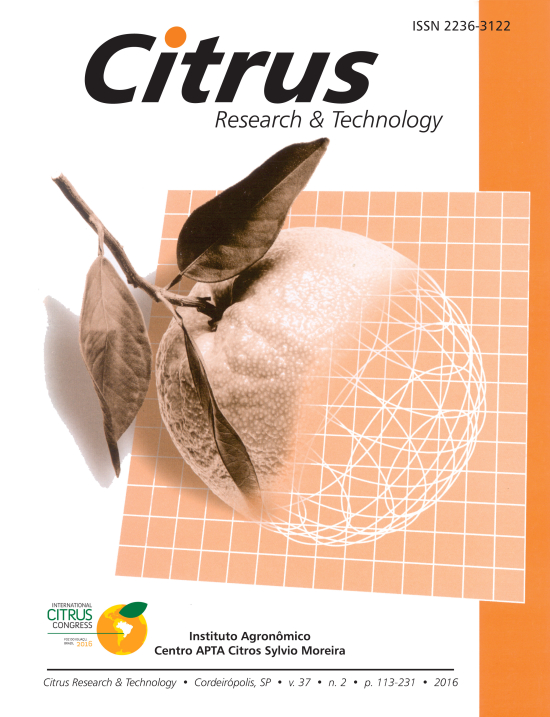GERMINAÇÃO DA SEMENTE DE PORTA-ENXERTOS DE CITROS EM FUNÇÃO DA PRESENÇA DO TEGUMENTO E SUA ORIENTAÇÃO NO SUBSTRATO
Germination of citrus rootstocks seeds according to their orientation and presence of the external tegument
Luís Fernando Carvalho Silva e Sérgio Alves Carvalho
Resumo
Como o direcionamento das raízes durante a emergência é uma resposta da planta à gravidade, a orientação da semente pode interferir na qualidade do sistema radicular. O presente trabalho foi desenvolvido, visando determinar o efeito da orientação da semente e do seu tegumento externo na germinação, expressão poliembriônica e qualidade do sistema radicular das plântulas de porta-enxertos de citros. O delineamento experimental foi de blocos casualizados em esquema fatorial 2 x 2 x 3, avaliando-se os dois porta-enxertos [limão Cravo (Citrus limonia Osbeck) e citrumelo Swingle (Poncirus trifoliata L. Raf. x C. paradisi Macfad.)], com e sem tegumento externo, e três orientações da semente: 1) horizontal; 2) vertical, com a micrópila para baixo; 3) vertical, com a micrópila para cima. A parcela foi composta por 25 sementes, utilizando-se quatro repetições. Efetuou-se a semeadura em bandejas plásticas com substrato à base de vermiculita e casca de pínus, avaliando-se, semanalmente, o número de plântulas germinadas. Ao atingirem 10 cm de altura, determinou-se a taxa final de germinação e de expressão poliembriônica. De acordo com a qualidade do sistema radicular, classificaram-nas ainda em tortas, normais e enoveladas. A retirada do tegumento determinou maior velocidade na germinação, sem influenciar a taxa final para os dois porta-enxertos. Diminuiu, entretanto, a taxa de poliembrionia para o citrumelo Swingle e a formação de raízes enoveladas para as duas variedades. Para os dois porta-enxertos avaliados, obteve-se o maior número de plântulas com raízes normais, quando se colocaram as sementes para germinar na orientação vertical com a micrópila para baixo ou horizontal, devendo-se evitar a orientação vertical com micrópila para cima.
Palavras-chave
Abstract
Taking into consideration that the vertical orientation of emerging roots is a response of plants to gravity, the orientation of the seed may interfere in the quality of the root system. This study was carried out to investigate the effect of the seed orientation and presence of the external tegument in the germination, polyembryony expression, and occurrence of deformations in seedlings root. The experimental design was the randomized blocks in a 2 x 2 x 3 factorial arrangement, to evaluate two rootstocks [Rangpur lime (Citrus limonia Osbeck) and Swingle citrumelo (Poncirus trifoliata L. Raf. X C. paradisi Macfad.)], with and without the external tegument, and three seed orientations (1 - horizontal, 2 - vertical with downward micropyle orientation, and 3 - vertical with upward micropyle orientation). Each plot was composed of 25 seeds, using 4 replications. Sowing was performed in plastic trays with pine bark and vermiculite as substrate. Data on seedlings germination were collected weekly. After reaching 10 cm in height, final rates of germination and polyembryony expression were determined. According to the root quality, seedlings were classified as crooked, regular, or curled. Removing the external tegument increased the germination speed, without influencing in the final rate for both rootstocks. It decreased however, the polyembryony rate for Swingle citrumelo and increased the formation of abnormal roots for the two varieties. For both rootstocks, a higher number of regular seedlings was obtained when germinating seeds were placed downward.

